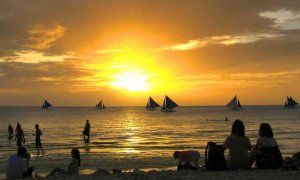DESTINATION IMAGE: The images of destinations contribute majorly in the destination choice of the tourists. “Image differentiates tourist destinations from each other and is an integral and influential part of the traveler’s decision process” (Baloglu and Brinberg, 1997). The intangibility of the destinations cannot be tested before purchase.

A mental representation of an object or place (Fridgen, 1987).
The visual or mental impression of a place, a product, or an experience held by the general public (Milman and Pizam, 1995).
Components of Destination Image (Gunn, 1972)
There are two components of Destination image: Organic and Induced. The organic image is formed by individuals own experience or, information through unbiased sources. Whereas, the Induced image built up due to advertising and promotion.
Any destination place can be viewed as a great weekend destination. The concerns of destination marketers are the identification, measurement and control of products’ image to attract customers.
Kotler, Haider and Rein (1993) define strategic image management (SIM) as the process of researching a place’s image among its audiences, segmenting and targeting its specific image and its demographic audiences, positioning the place’s benefits to support an existing image or create a new image, and communicating those benefits to the target audiences.
Kotler, Haider and Rein (1993) describe three approaches to measure the images.
i) Familiarity-favorability measurement of destination image
To check the familiarity of the destination respondents are advised to rate the place on 5 point scale explaining Never heard of it, Heard of it, Know a little about it, Know a fair amount about it and Know it very well.
Then, the respondents with some familiarity of the place are asked to explain the favorability of the destination again in 5 point scale as Very unfavorable, Somewhat unfavorable, Indifferent, Somewhat favorable and very favorable.
ii) Semantic differential
The semantic differential test the perception of respondents’ on a set of dimensions one prefers to spend holidays.
iii) Tools to communicate an image
There are three broad categories of tools for communicating a destination image:
Slogan or, theme – New Zealand portrayed the image of its enironment “The Environmental Destination of the 1990s”. Thus positioning through image of destination is a great idea as cited by Kotler et al (2002) Hong Kong – Asia’s World City
Visual symbols – The use of icons to showcase your destination is attractive too.Eg.- Eifell tower, Great Wall of China, Taj Mahal etc.
Events and deeds – The use of major cultural events or, sports to be identified with to promote the destination. The Local, Regional and Hallmark events classified according to the cultural events help in promoting the place. For instance – Olympic is one of the most fertile ground for any nation to promote the destination for tourism.
Kotler, Haider and Rein (1993) identified six image for destinations namely, positive (ie no need to change reach to more target groups); weak (places that are small are identified and to be advertised); negative (need to redefine the image by minimizing all negative aspects); mixed ( need for a strategy to emphasise selected aspects and rectify others); contradictory (different target groups with different expectations); and overly attractive (highly in demand the place to be restricted with the threat of overuse).Many destinations uses the celebrity endorsements to improve the attractiveness of the destination. Film star Amitabha Bachchan promoting Gujarat Tourism.
Incredible India Campaign advertising spiritual and exotic values of the nation is the most known and clear evidence of marketing of destination brand.




